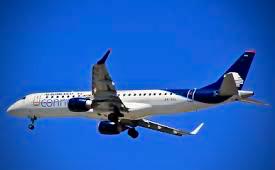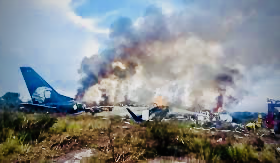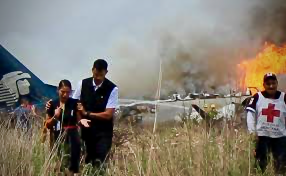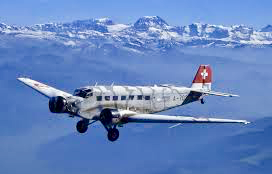ACCIDENT. Aeromexico 2431: Crash and Learn…Vs. Junkers.
VamoSetbacks: Incidents & Accidents (Premise).
If the Aeromexico plunge in Durango, Mexico teaches anything, it is that certain such disasters can be survived, with a measure of preparation, cooperative presence of mind, and planeloads of just plain luck.
So was it a one-in-a-million godsend or ‘miracle’ be design?
Some dramatic details: Aeromexico’s flight 2431, a Brazilian-made Embrear EJR-190AR took off from Durango’s General Guadalupe Victoria International Airport at about 3:30 pm on Tuesday, July 31 into rainy, densely overcast skies. The rain became a downpour at the jetliner increased runway speed, teeming stronger and stronger upon lift-off, visibility having dropped to zero. 
Barely gaining altitude, the aircraft—carrying 99 passengers and crew of four—was slammed by a microburst-like downdraft (or wind shear?). The Embraer plunged nose first and hit the grassy ground some 300 yards from runway’s end.
Already unnerved by an unusually shaky take-off, passengers began screaming as soon as the craft started rocking up and down with a loud bang. With that boom came lights-out darkness and sheer terror, heads hitting the ceiling, flight 2431’s cabin descending into fearful, shocked chaos.
But amid the screams, crying and final prayers, crew members shouted a bracing chorus of evacuation instructions. The plane was breaking apart in billowing smoke and the choke of leaking jet fuel. Still, flight attendants directed panicked passengers to pried open emergency doors and fractures in the fuselage, clearing the stricken craft moments before it was consumed by that smoke and flames.
The result? All but two relatively minor casualties were released from Durnago’s local hospital within several days; injured more seriously were pilot Carlos Galván Meyran and an 8-year-old girl burned over 25% of her body.
Howz & Whyz and Therefores.
A one-off ‘miracle’? Some witnesses claim that if the plane had been climbing any faster, higher, the crash would have been a disaster with untold fatalities. Aviation experts credit the Embraer’s advanced cabin (+seating) design and construction for absorbing the impact as well as it did.
Others cite the crash’s proximity to Durango’s airport, that if in remote lands or the sea, no such timely, heroic on-ground aid would have arrived. Nevertheless, passengers were led stunned and screaming, navigating a swirl of emotions through a muddy field, safely away from a plane that was quickly engulfed in flames.
Statistics tell us that airline safety has improved in recent years, that flying remains safer than other transport modes. Fatalities on steady decline: reassuring, to be sure, although not thoroughly remedial.
For storms will continue to hit, winds will still shear; runways remain too short at critical times, if not slick or visibly obscured. Aircraft engines will fail or explode; landing gear tires will blow, taxiway, runway mishaps will happen no end.
So we travelers should not simply rest assured, but would be better served by being better prepared:
According to the Air Transport Association, three conditions most determine the survivability of an airplane crash:
- The forces encountered by passengers beyond the limits of human bodily tolerance.
- Whether plane structure remains substantially intact and degree of damage. Perhaps impacted as well by its age and quality of maintenance (2431’s Ebraer was a decade old, Aeromexico being its third owner).
- If the post-crash environment presents immediate threats to the passengers or rescuers.
Moreover, survival tips and strategies abound:
Some say select safer seat rows, nearest emergency doors. Hold out for seats toward rear cabin. In any  case, keep count of rows to always know where you are, relative to those exits. Otherwise, keeping seat belts fastened in flight is advised, as is avoiding flammable attire.
case, keep count of rows to always know where you are, relative to those exits. Otherwise, keeping seat belts fastened in flight is advised, as is avoiding flammable attire.
But becoming more determinant and/or debatable of late is the carrying on about carry-on bags and luggage. Given baggage fees today, we travelers understandably strive to pack as much into our carry-ons as their capacity will allow. Mainly those zipper-busting c-o’s contain meds, valuable electronic devices and myriad other ‘personals’.
Passengers stuff them under seats and in overhead bins—roll-aboards as well—which creates problems enough regarding storage space limits and territoriality, particularly in coach class. Those stressors are compounded, however, when a flight enters emergency mode.
More specifically, in evacuation situations, most passengers insist on toting along carry-ons, even when an airplane cabin is collapsing or beginning to burn.
So aisles already clogged with panicked travelers, parents frantically searching for their separately seated children, are further stalled in place with others struggling to grab, drag along their bags and other belongings. They thereby add crucial minutes to the desperate plane clearing process, running the risk of trapping fellow passengers who are scrambling toward emergency exits from stricken craft, possibly puncturing inflated evacuation slides with their ‘carry-offs’.
Carriers Got a Brand New Bag.
The airlines are generally responding to this mounting hazard and safety threat with an array of approaches. Their measures range from locking overhead bin doors to the F.A.A. making mandatory now optional on-board instructions to ‘leave bags behind’ in emergency EVAC’s. Flight attendants, for example, would announce such procedures in verbal or on-screen preflight briefings, going beyond current setback pocket cards.
Each measure has its downsides, as in locked-door access if an overhead bin were to catch fire. Or passengers paying little attention or heed to pre-flight ‘bag leave’ presentations.
Still, the issue can affect our packing decisions, since checked luggage inside lower cargo bins would hardly be spared in the event of such emergencies/crashes. So where and what?
One thing though: As evacuation footage from the Aeromexico 2431 crash site shows, few if any of the escaping passengers appear to be carrying off bags and belongings as they flee, and are led away, for their very imperiled lives.
Developments on this front will be carried on from here forward, Vamigré seeing and telling what more we can learn from the devastating Aeromexico 2431 Embraer crash and its most amazing survival story…
Mexico Miracle vs. Fatal Junkers Junket.
Not so fortunate as Aeromexico 2431 was the outcome of a recent fatal crash of one Junkers JU-52-HB HOT in the eastern Swiss Alps.
The 1930s vintage German-built propeller plane—on a sightseeing tour from nearby Zurich— went down, killing  17 Swiss and Austrian passengers and a crew of three. Witnesses said the WWII craft appeared to turn 180-degrees to the south, then fall at high speed to the ground.
17 Swiss and Austrian passengers and a crew of three. Witnesses said the WWII craft appeared to turn 180-degrees to the south, then fall at high speed to the ground.
It perished at about 8,333 feet above sea level, on the western side of a nearly 10,000-foot mountain rise. No black box was found at the crash site, nor was there adequate tracking radar at that altitude to have fully charted Junkers’ course. More to come…
